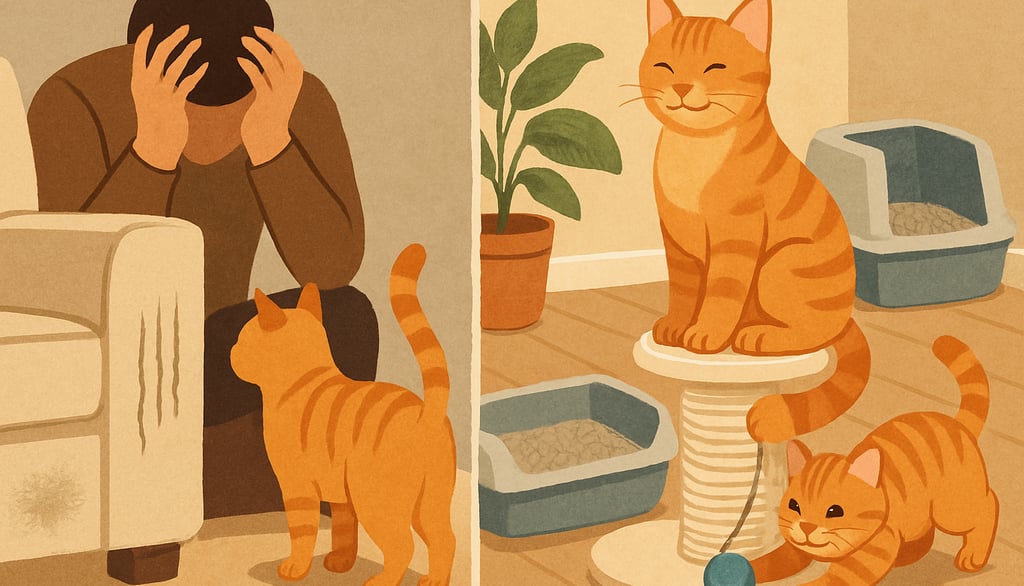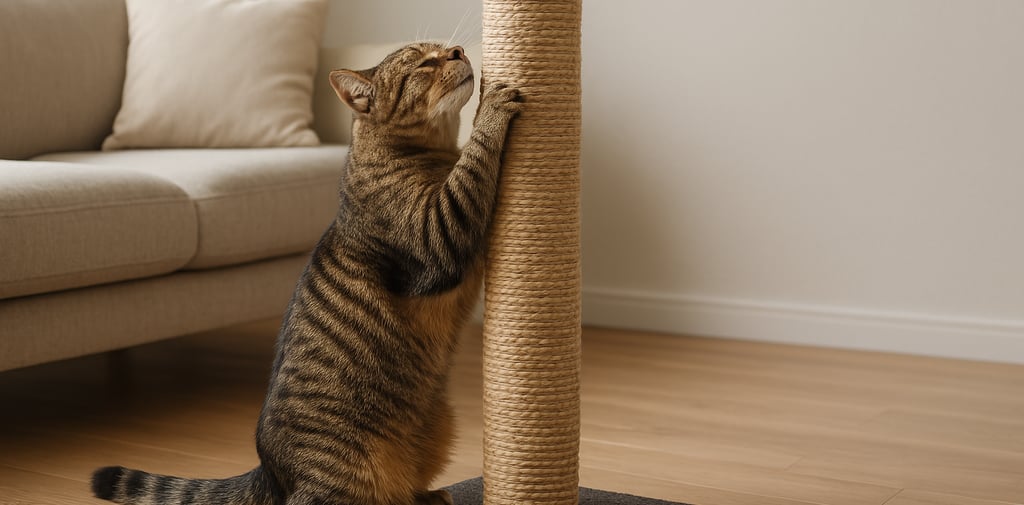Solving Common Cat Behavior Problems: Scratching, Spraying, and More (The Gentle Way)
UNDERSTANDING YOUR MYSTERIOUS FELINE


Living with cats is a wonderfully rewarding experience, but sometimes their natural behaviors can become problematic in a human household. Issues like destructive scratching, inappropriate spraying, or excessive vocalization can cause stress for both cats and their owners. The key to resolving these common behavior problems lies not in punishment, which can exacerbate issues and damage your bond, but in understanding the underlying causes and addressing them with patience, consistency, and positive reinforcement. This gentle approach focuses on meeting your cat's needs and redirecting undesirable behaviors towards acceptable outlets.
Understanding the "Why" Behind Problem Behaviors
Before you can effectively address a behavior problem, it’s crucial to understand why your cat is exhibiting it. Cats don’t engage in these behaviors out of spite or malice; there’s always an underlying motivation, often rooted in their natural instincts, environmental stressors, or unmet needs.
Scratching: This is a natural and essential behavior for cats. They scratch to mark their territory (both visually and with scent glands in their paws), to maintain claw health by removing the dead outer layer of their nails, to stretch their bodies, and to relieve stress or excitement.
Spraying (Urine Marking): Spraying is different from inappropriate urination due to a litter box issue. It’s a form of territorial communication. Unneutered male cats are most prone to spraying, but neutered males and females can also spray, especially if they feel insecure, stressed by changes in the household (new pets, people, furniture), or perceive threats from outside cats.
Inappropriate Urination/Defecation (Outside the Litter Box): This can be caused by a multitude of factors, including medical issues (urinary tract infections, kidney disease, arthritis making it hard to get into the box), dissatisfaction with the litter box itself (type of litter, cleanliness, location, size, number of boxes), stress, or conflict with other cats.
Excessive Vocalization (Meowing): Cats meow for many reasons: to greet you, to solicit attention or food, to express loneliness or boredom, due to medical issues (pain, cognitive dysfunction in older cats), or because they are in heat (unspayed females).
Important First Step: Rule Out Medical Issues
Any sudden change in behavior, especially concerning litter box habits or increased vocalization, warrants a trip to the veterinarian. Many behavior problems can be symptoms of underlying medical conditions that need treatment. Once medical causes are ruled out, you can focus on behavioral solutions.
Gentle Solutions for Common Cat Behavior Problems
1. Destructive Scratching
Provide Appealing Scratching Alternatives: The goal isn’t to stop your cat from scratching, but to redirect it to appropriate surfaces. Offer a variety of scratching posts and pads with different materials (sisal rope, cardboard, carpet, wood, natural bark) and orientations (vertical, horizontal, angled). Most cats prefer tall, sturdy vertical posts that allow them to fully stretch.
Strategic Placement: Place scratching posts in prominent locations, especially near your cat’s favorite sleeping spots (as they often scratch upon waking) and near the furniture they are currently scratching. If they are scratching a particular sofa arm, place an attractive post right next to it.
Make Unwanted Surfaces Unattractive: Temporarily cover the inappropriately scratched furniture with materials cats dislike, such as double-sided sticky tape (Sticky Paws), aluminum foil, or plastic furniture protectors. You can also use citrus-scented sprays (cats generally dislike citrus) on the unwanted areas, but test on an inconspicuous spot first.
Attract Them to the Posts: Make the new scratching posts irresistible. Sprinkle them with catnip (if your cat responds to it), hang a toy from the top, or use a pheromone spray like Feliway Classic, which mimics feline facial pheromones and can encourage marking by rubbing and scratching in appropriate areas.
Positive Reinforcement: When you see your cat using the scratching post, reward them immediately with praise, a gentle pet, or a small, high-value treat. This reinforces the desired behavior.µ
Nail Trims: Regularly trimming your cat’s claws (every 2-4 weeks) can reduce the damage they can inflict.
2. Spraying (Urine Marking)
Neutering/Spaying: This is the most effective solution, especially for sexually motivated spraying. Neutering male cats can eliminate or significantly reduce spraying in up to 90% of cases. Spaying females also helps.
Identify and Reduce Stressors: Determine what might be causing your cat to feel insecure or threatened. Is it a new pet? Changes in routine? Outdoor cats visible through windows? Try to minimize these stressors. For outdoor cat visibility, you can use blinds or opaque window film on the lower portions of windows.
Clean Sprayed Areas Thoroughly: Use an enzymatic cleaner specifically designed to neutralize pet urine odors. Regular household cleaners may not eliminate the odor completely for your cat, prompting them to re-mark the spot. Avoid ammonia-based cleaners, as they can smell like urine to a cat.
Increase Perceived Security: Provide more vertical space (cat trees, shelves), hiding spots, and ensure there are enough resources (food bowls, water bowls, litter boxes, resting spots) in multi-cat households, spread throughout the home to avoid competition.
Pheromone Therapy: Feliway Multicat (if inter-cat conflict is a stressor) or Feliway Classic diffusers can help create a calmer, more secure environment and reduce stress-related spraying.
Medication (as a last resort): In some persistent cases, your veterinarian may prescribe anti-anxiety medication to help manage spraying, but this should be used in conjunction with environmental and behavioral modifications.
3. Inappropriate Urination/Defecation
Veterinary Check: As mentioned, rule out medical causes first.
Litter Box Paradise:
Number: The golden rule is one litter box per cat, plus one extra, placed in different locations.
Size: Ensure boxes are large enough (at least 1.5 times the length of your cat from nose to base of tail).
Type of Litter: Most cats prefer fine-grained, unscented clumping litter. Offer a few different types in different boxes to see what your cat prefers.
Cleanliness: Scoop boxes at least once or twice daily and change the litter completely and wash the box with mild soap and water weekly or bi-weekly.
Location: Place boxes in quiet, low-traffic, easily accessible areas where your cat feels safe. Avoid placing them next to noisy appliances or in busy hallways. Some cats prefer covered boxes for privacy, while others prefer open ones.
Address Stress and Conflict: Similar to managing spraying, identify and mitigate stressors. Ensure peaceful coexistence in multi-cat homes by providing ample resources and separate feeding/resting areas if needed.
Retrain (If Necessary): Confine your cat to a smaller room with their litter box, food, water, and bedding for a short period. Once they are consistently using the box, gradually allow them access to more of the house.
4. Excessive Vocalization
Veterinary Check: Rule out pain, illness, or age-related cognitive decline.
Identify the Cause: Is your cat meowing for attention, food, to be let in/out, out of boredom, or loneliness?
Do Not Reward Unwanted Meowing: If your cat meows for attention, try to ignore the meowing and only give attention when they are quiet. If you give in to meows for food, you reinforce the behavior. Stick to scheduled feeding times.
Provide Enrichment: Combat boredom with regular interactive play sessions, puzzle feeders, cat trees, window perches, and a variety of toys. Rotate toys to keep them interesting.
Companionship: If your cat is lonely, consider if another pet is a viable option (after careful consideration of compatibility). If not, ensure you are spending quality time with them each day.
Address Nighttime Waking: If your cat meows at night, try a vigorous play session before bedtime, followed by a meal. Ensure their needs are met before you go to bed. Sometimes, earplugs for you might be necessary in the short term while you work on the behavior.
Solving cat behavior problems takes time, patience, and a commitment to understanding your cat’s perspective. By focusing on creating a supportive environment, meeting their instinctual needs, and using positive reinforcement, you can gently guide your cat towards more desirable behaviors, leading to a more harmonious and happy life together.
CTA Teaser: Struggling with a persistent feline behavior challenge? Our comprehensive guide, "Decoding Your Cat: A Guide to Feline Behavior & Communication," offers in-depth, humane, and effective solutions for a wide range of common issues, helping you restore peace and understanding in your home. Get your expert guide now!Solving Common Cat Behavior Problems: Scratching, Spraying, and More (The Gentle Way)




Sustainable Cat Care
At EcoCatCare, we provide resources that help cat parents discover how sustainable choices can create healthier, happier lives for their feline companions while contributing to a healthier planet.
EcoCatCare © 2025. All rights reserved
